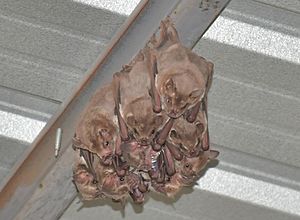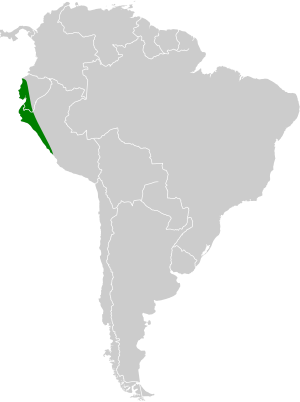Fraternal fruit-eating bat facts for kids
Quick facts for kids Fraternal fruit-eating bat |
|
|---|---|
 |
|
| Conservation status | |
| Scientific classification | |
| Genus: |
Artibeus
|
| Species: |
fraterculus
|
 |
|
| Synonyms | |
|
Artibeus jamaicensis fraterculus Cabrera, 1958 |
|
The fraternal fruit-eating bat (Artibeus fraterculus) is a type of bat that lives in dry areas of Ecuador and Peru. It belongs to the Phyllostomidae family. This bat used to be thought of as a smaller version (a subspecies) of the Jamaican fruit bat. However, in 1978, scientists decided it was its own unique species.
It's the smallest bat in a group of larger Artibeus bats. This group also includes the Jamaican fruit bat and the great fruit-eating bat. The fraternal fruit-eating bat has a forearm about 52–59 mm (2.0–2.3 in) long. Its total body length is around 64–76 mm (2.5–3.0 in), and it weighs about 30–55 g (1.1–1.9 oz).
This bat eats many different kinds of fruit, making it a generalist frugivore. It also eats some insects. It has babies in both the wet and dry season, with most births happening in February and May. The barn owl is the only known animal that hunts this bat, but other birds of prey and the spectral bat might also hunt it. Tiny creatures like bat flies, mites, and protozoans can live on or in these bats.
The International Union for Conservation of Nature (IUCN) lists the fraternal fruit-eating bat as a species of least concern. This means it's not currently in danger. It's common, lives in a large area, and its numbers aren't dropping much. However, in some places, it might be at risk from pollution, like heavy metal poisoning.
About the Fraternal Fruit-Eating Bat
How This Bat Got Its Name
The fraternal fruit-eating bat was first described in 1924 by a scientist named Harold Elmer Anthony. He found a specimen (a collected example) in Portovelo, Ecuador. For a while, it was considered a subspecies of the Jamaican fruit bat. But in 1978, another scientist, Karl Koopman, studied its body features and decided it was different enough to be its own species.
The name Artibeus comes from ancient Greek words meaning "straight" and "to walk." The second part of its scientific name, fraterculus, means "little brother" in Latin. This name was chosen because it's the smallest bat in its group of larger Artibeus bats. People also call it the "western artibeus" in English. In Spanish, it's known as "murciélago frutero fraternal."
The fraternal fruit-eating bat is one of 12 species in the Artibeus group. Scientists have studied its DNA and found that it's closely related to the hairy fruit-eating bat. These two bats are like "sister" species. They separated from other bat species about 2.3 million years ago. This bat's family tree suggests a past connection between bats in western South America and Central America.
What the Fraternal Fruit-Eating Bat Looks Like
The fraternal fruit-eating bat is the smallest of the large Artibeus bats. Its forearm is about 52–59 mm (2.0–2.3 in) long, and its whole body is about 64–76 mm (2.5–3.0 in) long. Adult bats weigh between 30–55 g (1.1–1.9 oz). It has the lightest color among South American Artibeus bats. It looks similar to Anderson's fruit-eating bat, but it's smaller.
These bats can be either grayish-brown or yellowish-brown. Their fur is soft and velvety, and it's short on their backs. The fur on their back is dark gray to dark brown. On their belly, the fur is pale and looks frosted because the tips of the hairs are silvery-gray.
The bat has a large head with a big snout and a noticeable, oval-shaped noseleaf. The noseleaf is a fleshy growth on its nose. Its ears and noseleaf, along with the skin on its forearm, lower leg, and finger bones, are pale brown. This color is different from its dark, blackish patagium (wing membrane). The tragus, a small flap in front of the ear, is gray to dark gray. Its feet and tail membrane (uropatagium) are dark brown. The wing membrane connects to the base of its thumbs. This bat does not have a tail. It has 30 teeth in total.
The fraternal fruit-eating bat has faint lines on its face that are hard to see. Some bats even have lower stripes that are almost invisible. In contrast, Anderson's fruit bats have thin, clear facial lines, and the great fruit-eating bat has very obvious facial lines. The flat-faced fruit-eating bat also has clear facial lines.
Bat Life and Habits
What the Bat Eats
The fraternal fruit-eating bat mostly eats fruit. It enjoys many different kinds, such as Ficus figs, mangoes, and loquats. It also eats fruits from trees like Brosimum alicastrum, Muntingia calabura, and Psidium guajava. Sometimes, it adds insects to its diet.
Reproduction and Life Cycle
The fraternal fruit-eating bat has a specific breeding season. It has babies twice a year, during both the wet and dry season. Even though births happen in both seasons, most babies are born in February and May.
Who Hunts the Bat
The only known animal that preys on the fraternal fruit-eating bat is the barn owl. However, other types of owls and the bat falcon might also hunt it. The spectral bat, which is a very large bat, could also be a predator.
Tiny Hitchhikers: Parasites
The fraternal fruit-eating bat can have tiny creatures living on or in it. These include streblid bat flies like Aspidoptera phyllostomatis and Megistopoda aranea. It can also have mites, such as Periglischrus iheringi. A protozoan called Trypanosoma cruzi can also be found in these bats.
How Bats Use Sound to See (Echolocation)
The fraternal fruit-eating bat uses echolocation to find its way around and hunt. This means it sends out high-pitched sounds and listens for the echoes. The sounds it makes start at a frequency of about 89.45–103.99 kHz and end at 59.18–84.09 kHz. Each sound lasts for about 1.61 milliseconds.
Where the Bat Lives
Habitat and Distribution
The fraternal fruit-eating bat is found in Peru and Ecuador. In Peru, it lives west of the Andes mountains in areas like Tumbes and Piura. It's also found in dry parts of the Amazon Basin in Cajamarca and Amazonas. In Ecuador, you can find it in central and southern coastal areas, and in the lower parts of the Andes mountains in the southwest.
These bats live in many different places, including forests, areas where the land has been changed by humans, and places with farms and cities. They are most often found in mangrove forests, dry scrubland, and forests where trees lose their leaves (deciduous) or some of their leaves (semideciduous). They are sometimes found in wetter areas too. They have been seen in humid mountain scrub in Loja, Ecuador. They can live at elevations from sea level up to about 0–2,145 m (0–7,037 ft).
In most of its range, the fraternal fruit-eating bat lives alongside Anderson's fruit-eating bat and the great fruit-eating bat. It also shares its home with many other bat species, including some that are only found in the Tumbesian Center of Endemism, a special region in the Andes. These bats roost (rest) in hollow trees, shrubs, caves, termite mounds, bridges, churches, houses, gardens, and mines. Many bats can roost together, from nine to hundreds of individuals.
Conservation Status
The International Union for Conservation of Nature (IUCN) lists the fraternal fruit-eating bat as a species of least concern. This is because it lives in a large area, is common, and its population numbers are not dropping significantly. It doesn't face major threats across its whole range. However, bats living in cities like Guayaquil in Ecuador have been found to have high levels of lead in their bodies. This means that heavy metal poisoning could be a local threat to these bats in some areas.
See also
 In Spanish: Artibeus fraterculus para niños
In Spanish: Artibeus fraterculus para niños


